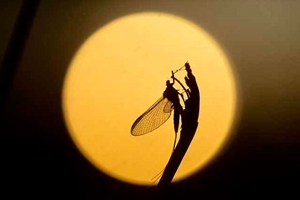Mayfly
 Many fishermen, I’m sure, will on occasions dream of crystal clear bubbling waters, with a fluttering blizzard of delicate mayfly dancing on the warm breeze above, while speckled sleek brown trout rise to gorge themselves on the abundant food supply.
Many fishermen, I’m sure, will on occasions dream of crystal clear bubbling waters, with a fluttering blizzard of delicate mayfly dancing on the warm breeze above, while speckled sleek brown trout rise to gorge themselves on the abundant food supply.
There are 51 species of mayfly in Britain belonging to the order Ephemeroptera, which translated from Greek means “living a day”, demonstrating just what a short life existence the adult mayfly has, with most only living a day or two. The name ‘mayfly’ is, in fact, a little misleading, as different species can be seen throughout the year, but perhaps they are at their most abundant in May and June.
A mayfly’s life starts in this frenzied, co-ordinated swarming of adults above the water, where mating takes place. The female then descends to the water’s surface to lay her eggs (some species actually enter the water to lay their eggs), which slowly sink to the bottom and stick to plants or stones.
The nymphs hatch out and spend their time foraging on the bed of the stream, eating algae and plants, and can spend up to two years before they are ready to emerge from the water. Mayflies are unique in that they have two adult winged stages. The nymph climbs up a plant stalk to the water’s surface, where the sexually immature adult emerges and flies off to hide within bankside vegetation. After a short while it will moult again, this time producing a fully sexually mature adult, which will join many others to dance above the water, starting the process off once again.
Mayfly are an important part of the food chain in many water systems, not only within fast flowing rivers and streams, but also sluggish canals and even ponds, in which some mayfly species specialise. They can also be an indicator as to what state the water is in. Many famous trout and salmon water courses no longer have these fabulous displays of millions of mayflies dancing above the water in May and June, but instead only a paltry few now give us the pleasure of their display.
There are possibly many reasons for this huge decline, including water abstraction, which creates reduced water flow; pollution from pesticides; increased siltation of rivers from agricultural land (not helped by septic tank overflow), which suffocates the river bed and in turn brings increased nutrients to the system; and, of course, general pollutants from industry.
Most of these individual issues probably merge together in many water courses, resulting in the diminishing display of the mayfly dance that we are witnessing. Much of this has only really happened in the last 50 years or so, which is made so much worse by the fact that mayflies were one of the first winged insects to inhabit the world, with fossils dating back over 300 million years. The mayfly’s dancing spectacle has until lately, been one of the longest-running shows in the world.
Peter Thompson
Advisory

Download Peter Thompson's essential 26-page book, featuring beautiful photography and detailed profiles of Britain's wildlife
Download FREE >